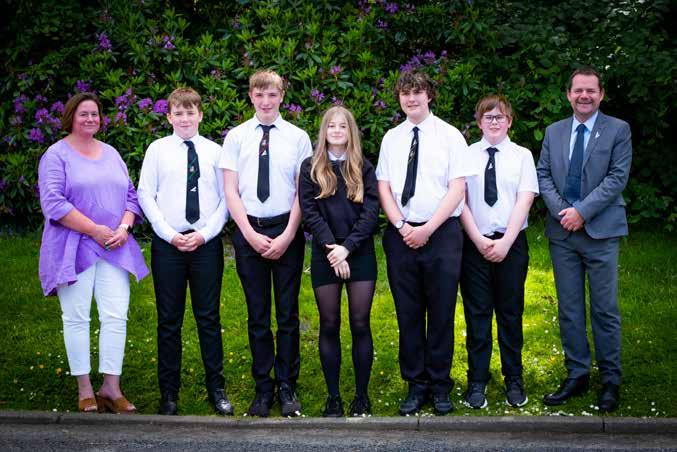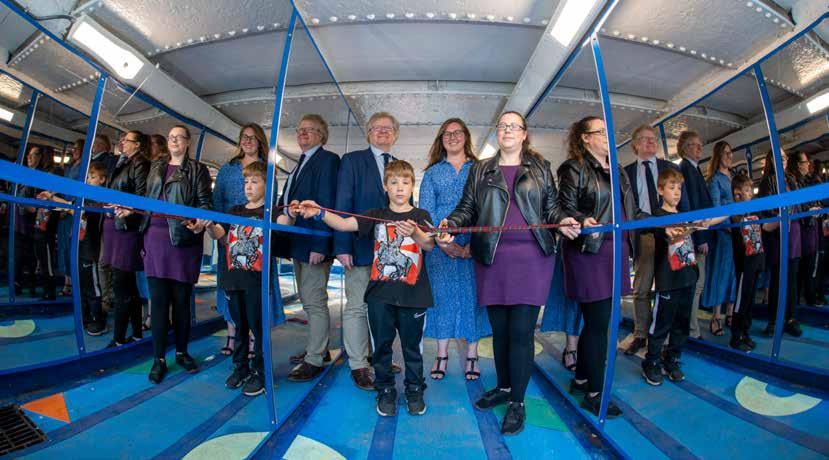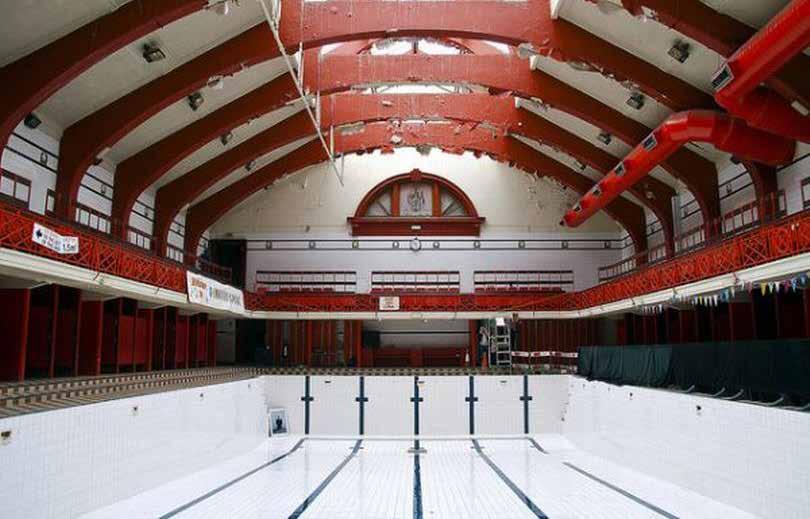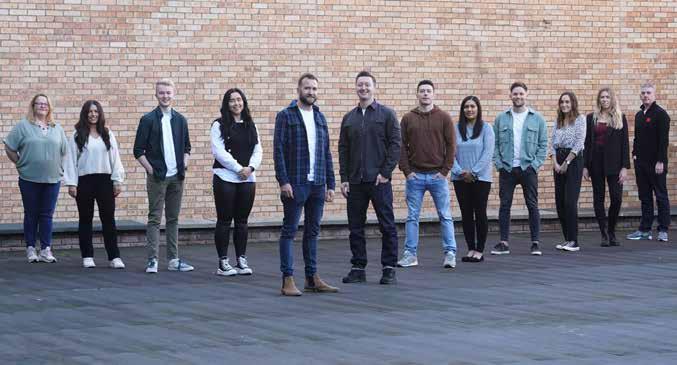
11 minute read
Administration & Legal
Work has now started on a transformation of Paisley Arts Centre which will add new modern performance facilities and an extension to the muchloved historic venue.
Advertisement
The building is being upgraded as a unique and intimate performance venue and creative hub, which will drive new life and footfall into the heart of the town centre when it reopens next year.
Workers are now on site at the building, in New Street, with the refurbishment to include:

• a redesigned public space at the front of the building, removing the railings and adding new paving and seating; • a small extension housing a new entrance and expanded bar area for pre-and post-show drinks; • improved main auditorium, with new retractable seating and a better audience experience; • new back-of-house and performance facilities, including better sound and lighting, new kitchen, improved dressing rooms, and workshop space for rehearsals and other events;
The programme of work has been designed to be sensitive to the 250-yearold site’s previous use as a former church. The graveyard area at the side of the building will be left untouched.
Extensive surveys were carried out to establish if there were any graves in the area in front of the building, where work is taking place. One monument at the front of the building will be repositioned slightly but surveys showed no grave is present underneath it.
The refurbishment is part of a wider investment in Paisley’s cultural venues by Renfrewshire Council, which supports Future Paisley – the wideranging programme of events and activity using the town’s internationally-significant cultural and heritage story to change the area’s future.
This includes the transformation of the town’s museum into a world-class visitor destination, the work to preserve Paisley Town Hall’s place at the heart of local life by turning it into a modern entertainment venue, and building a new home for library services in a formerly-empty retail unit at the heart of Paisley High Street.
When they reopen, the venues will be operated by OneRen, the charity which provides culture, leisure and sport opportunities to help people enjoy active and healthy lives in Renfrewshire. The reopened arts centre will host a year-round programme of music, comedy, theatre and much more.
Cllr Lisa-Marie Hughes, chair of OneRen, said: “I am delighted to see work is now under way on the refurbishment of Paisley Arts Centre.
“For more than 30 years, it has been one of Scotland’s most vibrant small arts venues, but while work was done to the outside of the building in 2012, the facilities and audience experience inside it were in need of the upgrade which this work will deliver.
“Once reopen, the building will be able to offer a better range of events than before, bringing new life and footfall into the town centre and to the surrounding businesses day and night.
“And we hope it will also become a hub for the town’s thriving creative community – providing a base for our cultural groups to work from and help nurture the next generation of local talent.” Michael Scanlan, Director at Clark Contracts – the main contractors for the work – added: “As a Paisley-based contractor, we are delighted to be working with Renfrewshire Council again to deliver this transformation of Paisley Arts Centre, which will provide highquality facilities for the local community.”

Artists impression of the main auditorium
Scotland’s oldest surviving manuscript goes on display at Aberdeen Art Gallery
For the first time in hundreds of years, the 10th-century Book of Deer has returned to the North East, where it may have originated.
The rare example of a pocket gospel will be on display at Aberdeen Art Gallery, on loan from Cambridge University Library.
The exhibition is supported by The
National Lottery Heritage Fund.
The Book of Deer is of enormous cultural importance to Scotland and has particularly strong links to the North
East. Written primarily in Latin, it dates from between the years 850 and 1000 and is believed to be the earliest surviving manuscript produced in Scotland. Its 86 vellum folios contain the New Testament accounts of Christ’s life and teachings written by his followers Matthew, Mark,
Luke and John. Unlike richly-decorated large-scale ceremonial manuscripts, such as the Book of Kells or the Lindisfarne
Gospels, the Book’s small size (it measures 157mm x 108mm) and modest decoration indicate that it is intended for private reading and prayer.
The Book contains a series of captivating illustrations: formal full and half-page depictions of what are believed to be the authors of the four gospels, and a series of later additions in the margins of the second half of the Book, showing human figures, animals, birds and shapes. While the identity of the scribe is unknown, the
Book ends with a request from them directly to the reader: “Be it on the conscience of anyone who reads this splendid little book that they say a prayer for the soul of the wretch who wrote it.” 2 It is the Book’s Gaelic notes which are truly remarkable. These notes, or marginalia, were later additions, dating from the 1100s and are the earliest known surviving examples of written Gaelic. They refer to the monastery of Deer in Aberdeenshire, and other places such as Pitfour and Ellon.
They tell how St Columba and his follower
Drostan travelled to the area from Iona and were given the land by a local leader after his son recovered from a serious illness thanks to Columba’s prayers. Columba gave the land to Drostan to found a church. As part of the Book of Deer Project 2022 the latest in a series of archaeological digs is underway which hopes to find the site of the early medieval monastery.
Alongside the Book of Deer, four volumes from the medieval Aberdeen Burgh Registers which also contain illustrations will be on display. Starting in an unbroken run in 1398, Aberdeen has the oldest and most complete civic archive in Scotland, with the earliest eight volumes spanning 1398 to 1511 recognised by UNESCO as being of outstanding historical importance to the nation.
The exhibition is part of a wider programme in Aberdeen and Aberdeenshire delivered by The Book of Deer Project and its partners, supported by The National Lottery Heritage Fund to celebrate the Book of Deer’s temporary return. It includes talks and tours, storytelling, creative writing, illustration and textile workshops, family trails and a special Gallery Late event at Aberdeen Art Gallery on 30 September which invites revellers to ‘party like it’s 1399’ and solve a medieval murder mystery.
The Lord Provost of Aberdeen, Councillor David Cameron, said: “I congratulate all the partners who have worked together to bring the Book of Deer ‘home’ to the North East for the first time in hundreds of years. There can be no doubt that the ‘splendid little book’ is one of Scotland’s greatest treasures.
“Visitors to the Art Gallery will have a rare opportunity to see it up close, as well as the chance to learn more about its significance and what it can tell us about this fascinating period in Scotland’s history through the associated programme of talk and activities. “The Book contains the earliest examples of Scots Gaelic in its margins and to highlight the importance of the Gaelic language in Scottish culture the exhibition text is available in both Gaelic and English – a first for an exhibition at the Art Gallery.” Anne Simpson, Chair of the Book of Deer Project, said: “The Book of Deer Project is delighted to realise its long-term ambition to have this precious wee book exhibited in the North East of Scotland where it can be seen by the many visitors to Aberdeen Art Gallery. It’s such an important part of Scotland’s history and culture, that’s perhaps not as well-known as it should be. This exhibition provides an opportunity for it to be better known and appreciated.” Dr Jessica Gardner, University Librarian and Director of Library Services, Cambridge University Library, said: “The Book of Deer is of supreme cultural importance to Scotland generally, and to the North East of Scotland in particular. “We are delighted to be a partner in this project, which offers an unparalleled opportunity to connect new audiences with The BOOK OF heritage in an inspirational way that will leave a lasting legacy.” Caroline Clark, The National Lottery Heritage Fund Director for Scotland, said: Project “ The Book of Deer may be a small book but it is a huge piece of history. Thanks to the marginalia it also has a very human and personal connection to a chapter in the story of Scotland from 1000 years ago. Those notes in the margins even let one individual speak to us, as readers, across the centuries. “Thanks to National Lottery players the Heritage Fund has been able to support this project to bring the Book back to the North East for public display. I have no doubt there will be of huge amount of interest in seeing this genuinely unique little book.”
©Cambridge University Library

All images of the Book of Deer reproduced by kind permission of Cambridge University Library
A splendid little book
During Scotland’s Year of Stories the remarkable 10th-century Book of Deer illuminated manu script is returning to the North-East of Scotland for the first time in more than 1,000 years. With support from the National Lottery Heritage Fund, The Book of Deer Project community heritage group has secured the loan of this exquisite little book, thought to be Scotland’s oldest surviving manuscript, from Cambridge University Library. Join us as we celebrate its return, and discover its fascinating story through a rich programme of events and activities for all ages in Aberdeenshire and the City of Aberdeen, including an archaeological dig, expert talks, original music, storytelling, creative workshops and an unmissable exhibition. www.bookofdeer.co.uk
Replacement for Peebles High School granted planning permission

An artists impression of the new school, due to be completed in 2025
Planning permission has been granted for the construction of a state-of-the-art campus in Peebles, marking an important next step in the replacement of the existing High School which was seriously damaged in a fire in 2019.
The decision will pave the way for further planning, design and development to be undertaken alongside further consultation with the local community to talk through the approved plans and the immediate next steps before construction begins.
A world-class modern learning space featuring attractive atrium spaces for collaboration and interaction, as well as breakout spaces for flexible teaching, will be built across two storeys on one of the existing grass pitches within the existing
High School boundary.
The new facility will be constructed whilst the existing school remains operational, avoiding significant disruption for pupils and ultimately delivering a world-class education and community facility.
Designed with involvement from the community, the campus will benefit the wider community providing an active landscape with opportunities for team sports, exercise classes, and routes for walking and running.
Also included in the development is an extension of the existing sports block, with a new multi-purpose 3G pitch built.
Starting later this month on 28 July, a three month programme of water diversion works to install a mains water pipe will commence on Bonnington Road and Craigerne Lane running until 21 October. The contractor undertaking the works will be WSP, on behalf of Scottish Water. Access to the school will not be affected.
Construction on the building itself is scheduled to begin later this year with the new facility to be constructed whilst the existing school remains operational, avoiding significant disruption for pupils. The entire development is due to be completed in 2025.
Councillor Leagh Douglas, Executive Member for Education & Lifelong Learning said: “The approval of planning for the state-of-the-art replacement of Peebles High School is very welcome news and signifies an important next step in the project’s timeline.
“This new campus will be transformational for both the students who will benefit from class educational facilities and the wider community who will have access to the many facilities on offer.
“Throughout this process we have put community consultation at the heart of the design and development of this project to ensure we are creating a building that they can be proud of and that will deliver wideranging benefits for decades to come.
“In the coming weeks, the project delivery team will hold a follow on public meeting to show the approved plans to the community, details of which will be shared in due course.”
Scott Brown, Hub South East’s Project Director, said: “Achieving planning permission is a key step in the development of a fantastic new learning space for Peebles. Stallan-Brand’s inspiring designs have been well received and we look forward to further developing these as the project progresses.
“Working in partnership with Scottish Borders Council and our contractor BAM Construction, we will deliver a facility which supports a modern learning experience for pupils and is an asset to the local community, whilst realising a range of local benefits and social value.”










